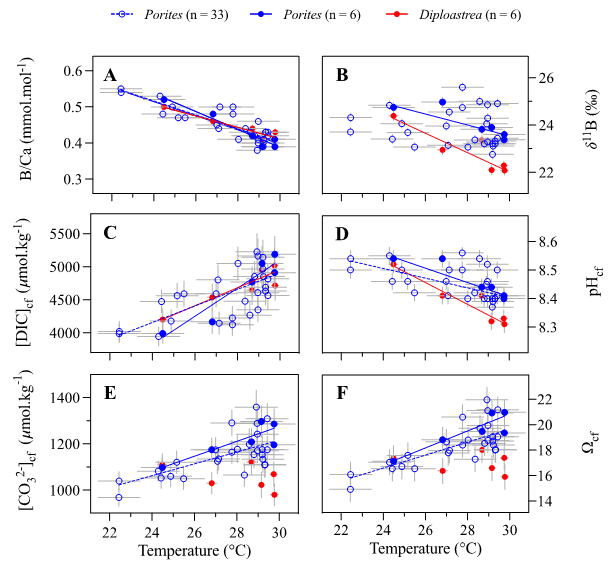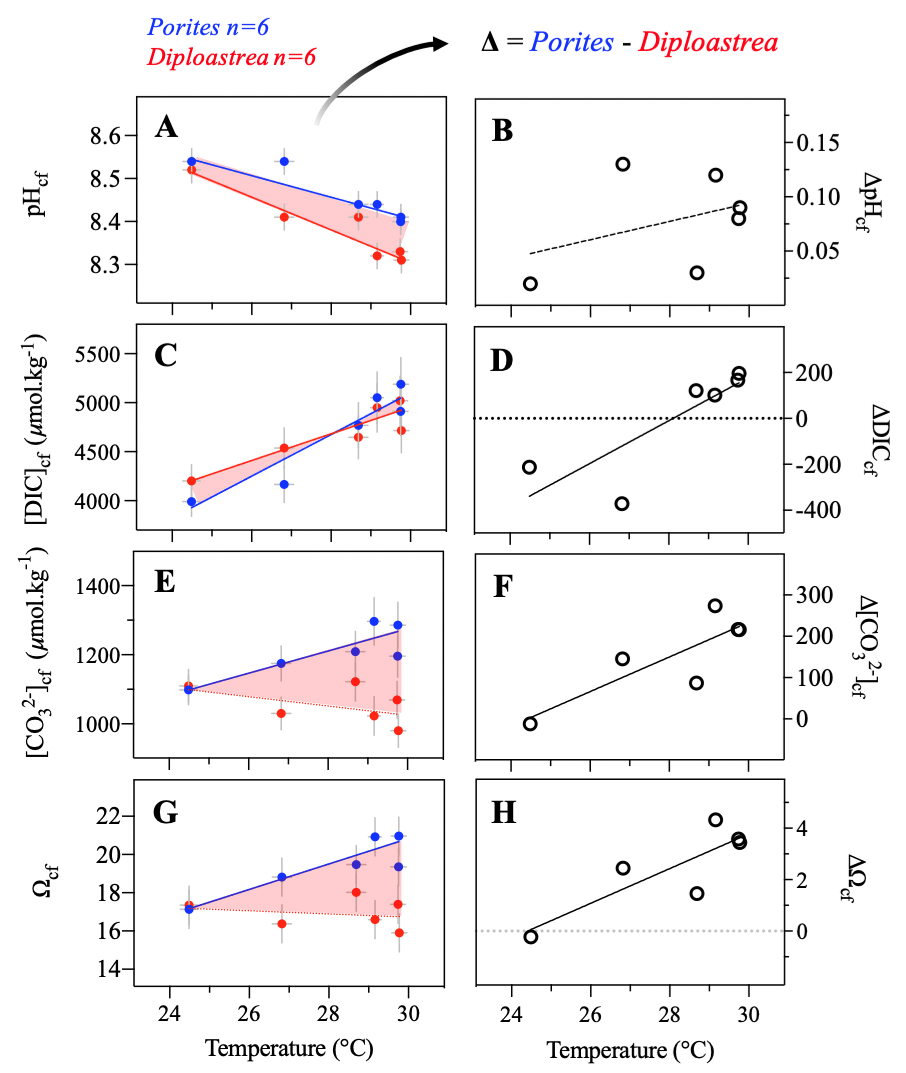Differences in carbonate chemistry up-regulation of long-lived reef-building corals
With climate projections threatening the future survival of stony corals and their dominance as tropical reef builders, it is critical to understand the adaptive capacity of corals to ongoing climate change. Biological mediation of the carbonate chemistry of the coral calcifying fluid is a fundamental component for assessing the response of corals to global threats. The Tara Pacific expedition (2016-2018) provided an opportunity to investigate calcification patterns in extant corals throughout the Pacific Ocean. Cores from colonies of the massive Porites and Diploastrea genera were collected from different environments to assess calcification parameters of long-lived reef-building corals.

Fig. 1. Coral skeletal composition. (A) B/Ca and (B) δ11B values of Porites (n = 33, blue) & Diploastrea (n = 6, red) corals across the Pacific Ocean plotted against SST. (C-F) Carbonate chemistry variables of calcifying fluid calculated for each colony (DICcf, pHcf, [CO32-]cf, Ωcf, respectively) against SST. The filled blue and red dots represent the 6 sites where both Porites and Diploastrea were sampled.
At the basin scale of the Pacific Ocean, we show that both genera systematically up-regulate their calcifying fluid pH and dissolved inorganic carbon to achieve efficient skeletal precipitation. However, while Porites corals increase the aragonite saturation state of the calcifying fluid (Ωcf) at higher temperatures to enhance its calcification capacity, Diploastrea shows a steady homeostatic Ωcf across the Pacific temperature gradient. Thus, the extent to which Diploastrea responds to ocean warming and/or acidification is unclear, and it deserves further attention whether this is beneficial or detrimental to future survival of this coral genus.

Fig. 2. Correlations between SST & calcifying fluid composition in co-occurring Porites (n = 6, blue dots) and Diploastrea (n = 6, red dots) specimens across the Pacific Ocean. Solid blue and red lines in the left panels indicate significant correlations.
Reference: Marine Canesi, E. Douville, P. Montagna, M. Taviani, J. Stolarski, L. Bordier, A. Dapoigny, G. E. H. Coulibaly, A.-C. Simon, M. Agelou, J. Fin, N. Metzl, G. Iwankow, D. Allemand, S. Planes, C. Moulin, F. Lombard, G. Bourdin, R. Troublé, S. Agostini, B. Banaigs, E. Boissin, E. Boss, C. Bowler, C. de Vargas, M. Flores, D. Forcioli, P. Furla, E. Gilson, P. E. Galand, S. Pesant, S. Sunagawa, O. Thomas, R. Vega Thurber, C. R. Voolstra, P. Wincker, D. Zoccola, S. Reynaud (2023). Differences in carbonate chemistry up-regulation of long-lived reef-building corals. Scientific Report, 41598. DOI : 10.1038/s41598-023-37598-9
The ‘forest’ of Notre dame de Paris: a path into medieval climate and time
 Notre-Dame de Paris, the so famous Catholic cathedral standing on Ile de la Cité in Paris, was built in 1163, largely completed by 1260, then frequently modified in the following centuries until a major restoration between 1844 and 1864. All these steps of construction and modifications involved the frame, so-called “la forêt” (the forest). So, the woods used throughout the cathedral’s history are samples and memories of the forests of oaks grown in the Paris Basin since the Middle Ages. The unfortunate destruction of the cathedral on 15th April of 2019, which miraculously spared a part of the frame, made these woods accessible to the scientific community. Some scientists are particularly interested in the isotopic composition of wood as memory of past climate and as a clock to the past. On one part, the oxygen and carbon isotopes (d13C and d18O) of tree-ring cellulose will bring light to past climate. Indeed, the isotopic composition of this component is determined by the conditions surrounding the trees during their growth. The variations of d13C and d18O with time, recorded in the successive rings built by the trees year after year, allows reconstructing the evolution of some environmental or climatic parameters such as temperature or humidity. Isotope dendroclimatology, a rapidly expanding field of investigation, is applied to old living trees, sub-fossil woods from buildings or even fossil material to reconstruct past climate. This methodological approach will be applied to the cathedral's oak timbers that have escaped severe charring and to contemporaneous unburned woods from other buildings (Figure 1). On the other part, measuring ring by ring the residual content of 14C isotope in cellulose will make it possible to refine the 14C clock which allows to date any material containing carbon. This will be achieved by providing new portions of the global calibration curve for the continental Western Europe from the 12th to the 18th century, from uncharred "forest" of Notre-Dame.
Notre-Dame de Paris, the so famous Catholic cathedral standing on Ile de la Cité in Paris, was built in 1163, largely completed by 1260, then frequently modified in the following centuries until a major restoration between 1844 and 1864. All these steps of construction and modifications involved the frame, so-called “la forêt” (the forest). So, the woods used throughout the cathedral’s history are samples and memories of the forests of oaks grown in the Paris Basin since the Middle Ages. The unfortunate destruction of the cathedral on 15th April of 2019, which miraculously spared a part of the frame, made these woods accessible to the scientific community. Some scientists are particularly interested in the isotopic composition of wood as memory of past climate and as a clock to the past. On one part, the oxygen and carbon isotopes (d13C and d18O) of tree-ring cellulose will bring light to past climate. Indeed, the isotopic composition of this component is determined by the conditions surrounding the trees during their growth. The variations of d13C and d18O with time, recorded in the successive rings built by the trees year after year, allows reconstructing the evolution of some environmental or climatic parameters such as temperature or humidity. Isotope dendroclimatology, a rapidly expanding field of investigation, is applied to old living trees, sub-fossil woods from buildings or even fossil material to reconstruct past climate. This methodological approach will be applied to the cathedral's oak timbers that have escaped severe charring and to contemporaneous unburned woods from other buildings (Figure 1). On the other part, measuring ring by ring the residual content of 14C isotope in cellulose will make it possible to refine the 14C clock which allows to date any material containing carbon. This will be achieved by providing new portions of the global calibration curve for the continental Western Europe from the 12th to the 18th century, from uncharred "forest" of Notre-Dame.
Figure 1: Modus Operandi we will follow to reconstruct past climate and past atmospheric 14C records at annual scale. 14C record is expected to complete the next 14C calibration curve and perhaps to highlight past solar events.
Reference: Daux V., Hatté C., duBoisgueheneuc D., Beck L., Richardin P. The ‘forest’ of Notre dame de Paris: a path into medieval climate and time. Journal of Cultural Heritage, In press


